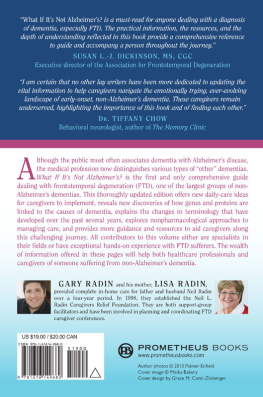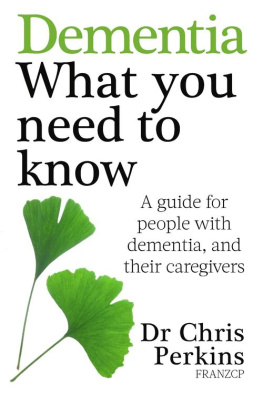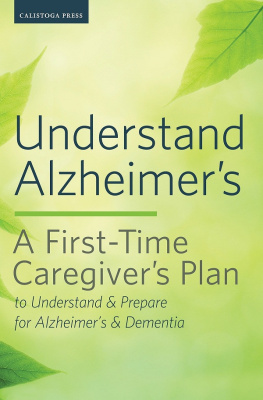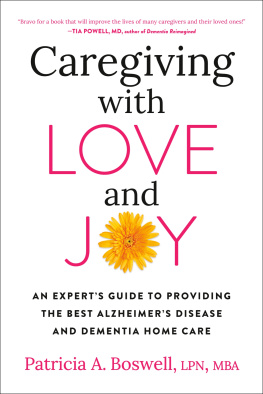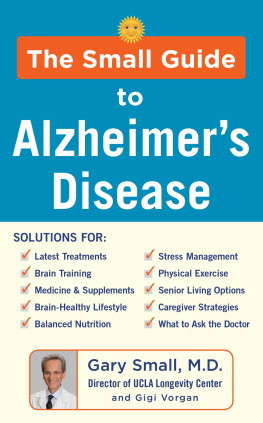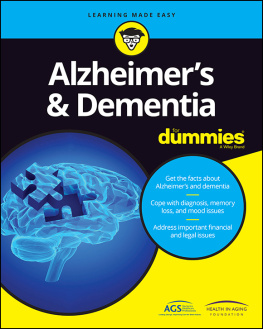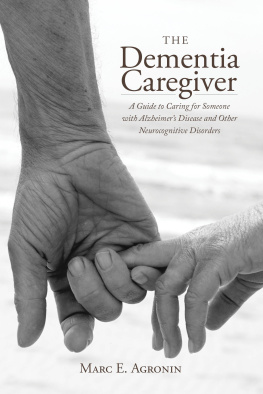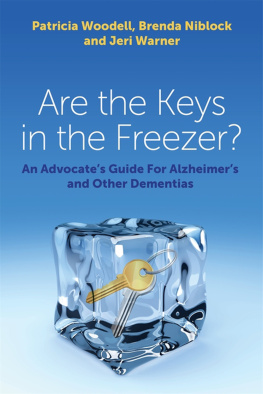
Creating a book of this scope was no small task. However, in light of the monumental difference it could make in the lives of those caring for someone with frontotemporal degeneration (FTD), it was worth every minute. The idea of assembling the thoughts, knowledge, and expertise of this ensemble of talented professionals and caregivers was both exciting and overwhelming. The number of titles and credentials following the names of the writers in this book is impressive. They are experts who have dedicated their lives to caring and providing for people whose loved ones have FTD, as well as researching and contributing to the future care of FTD patients.
We also owe our gratitude to the many families, friends, and professionals, too numerous to mention, who supported us and cared for our loved one during the most difficult time of our life. You are truly at the source of our commitment to take our experience and turn it into something that will help others as they face the role of caregiving.
We are so grateful and thankful for the incredible generosity that each and every contributor has made to this endeavor. Their efforts go far beyond the writing of this book. They offer information, guidance, and hope for all those who come into contact with the challenges and reality of living with FTD.
We want to thank Murray Grossman, MD, EdD, for his ongoing encouragement to create this book and for his personal commitment to patients and families dealing with dementia. He is a role model for the medical profession. Jennifer Farmer, MS, CGC, has given spirit, knowledge, and many hours to ensure that we have included everything caregivers need to know and that all the contributors to this book have been well represented. She is an angel that descended upon this project. Helen-Ann Comstock is a pioneer in supporting, educating, advocating, and loving both caregivers and FTD patients in need in our region. Carol Lippa, MD, has proven time and again that caregivers and their loved ones deserve knowledge they can understand and take home into everyday life. Landmark Worldwide's transformative educational experience beginning with the Landmark Forum has allowed us to overcome our fears and create ongoing new possibilities for life. We also acknowledge the contributing authors, without whom this book would never have been possible: Kate J. Bowen; Richard J. Caselli, MD; Jeannette Castellane; Heather Cianci, PT, MS, GCS; Helen-Ann Comstock; Rev. David Cotton; Sharon S. Denny, MA; Susan L.-J. Dickinson, MS, CGC; Lisa Ann Fagan, MS, OTR/L; Paul L. Feldman, Esq.; Maribeth Gallagher, DNP, PMHNP-BC, FAAN; Rosalie Gearhart, RN, MS, CS; Vivian E. Greenberg, ACSW, LCSW; Murray Grossman, MD, EdD; Geri R. Hall, PhD, ARNP, GCNS-BC, FAAN; David J. Irwin, MD; Morris J. Kaplan, Esq., NHA; David S. Knopman, MD; Virginia M.-Y. Lee, PhD; Carol F. Lippa, MD; Amy P. Lustig, PhD, MPH, CCC-SLP; Lauren M. Massimo, PhD, AGNP-BC; Elisabeth McCarty Wood, MS; Bruce L. Miller, MD; Darby Morhardt, PhD, LCSW; Mary O'Hara, AM, LCSW; Katherine P. Rankin, PhD; Keith M. Robinson, MD; Martin Rossor, MD, FRCP, FMedSci; John Q. Trojanowski, MD, PhD; and Roy Yaari, MD, MAS.
In addition, we'd like to thank the Alzheimer's Association Delaware Valley Chapter, Pick's Support Group for its love, caregiver words of wisdom, and bravery in the face of fear; Fytie Drayton and Joyce Shenian, special caregivers and friends, who have given their blessing for this book and invaluable feedback and unconditional support to all those around them; all the caregivers who responded to our questionnaire; our close family and friends for their interest and supportespecially Geri for her love and compassion and Vince for his ongoing patience, humor, and willingness to let us disappear as we worked for hours and even days at a time.

Lisa Radin and her son, Gary Radin, provided complete care for their husband and father Neil Radin over a four-year period after he was diagnosed with frontotemporal degeneration (FTD). Based on this firsthand experience with a devastating and terminal illness, they compiled this collection of expert articles on FTD and dementia. In 1998, following Neil's death, they founded the Neil L. Radin Caregivers Relief Foundation based in New Jersey, and in 1999 were involved in planning the first Multidisciplinary Conference on Pick's Disease and Frontotemporal Dementia in Philadelphia. In 2000, Lisa also helped organize the Frontotemporal Dementia and Pick's Disease Criteria Conference at the National Institutes of Health in Bethesda, Maryland. In 2003, she became a founding member of the Association for Frontotemporal Degeneration and is currently a special-events consultant for the Alzheimer's Association Delaware Valley chapter. Gary and Lisa continue to support fundraising efforts for these organizations, speak about their experience as caregiver's and are both facilitators for support groups serving those in need.
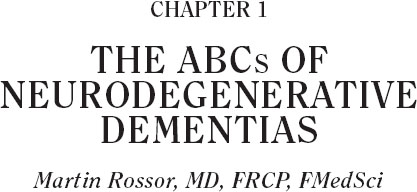
WHAT IS DEMENTIA?
The most common cause of dementia is Alzheimer's disease (AD), which has dominated our thinking about neurodegenerative disorders and even determined the definition of the term dementia itself. It is clear, however, that there are many other causes of dementia. Before discussing these it is first necessary to consider what is meant by dementia and the history behind it.
The term dementia refers to a clinical syndrome, a combination or pattern of clinical features. Thus, dementia is not a disease but rather a syndrome that can be associated with many different underlying diseases. In this sense it is similar to heartburn or headache, which is caused by many different things and could require many different treatments. Therefore, the statement that somebody has dementia is an inadequate diagnostic formulation: One must always try to determine the cause by appropriate investigations.
With the syndrome dementia, impairment of cognitive function is widespread. It can involve, in different combinations, memory for events; memory and understanding of facts, language, thinking, and reasoning; and perception of the world. Identifying patients with this combination of cognitive impairment was particularly important in the days before imaging (e.g., MRI and CT). It was important to distinguish patients with a localized deficit from those with more widespread problems. Cognitive function in the brain is modular, and particular areas of the cerebral cortex are specialized for particular functions; for example, our ability to remember day-to-day events is critically .)

Figure 1.1. Illustration of the major areas of the brain.
What the Different Parts of the Brain Do
Cerebrum: This is the term for the major part of the brain. The cerebrum is responsible for many aspects of thinking, including memory, problem solving, language function, personality, mood, and response to different sensory signals from the world around us. It also plays a role in movement and in feeling the senses. It is highly developed in humans but more rudimentary in animals.
Cerebellum: This part of the brain coordinates, smoothes out, and balances movement to enable us to stand, walk, and use our arms.
Frontal lobe: This part of the brain controls our ability to use words and speech (the left side) and determines how we react to situations. The frontal lobes are also important for problem solving, mood, judgment, inhibiting impulses, and for individual personality.
Next page
